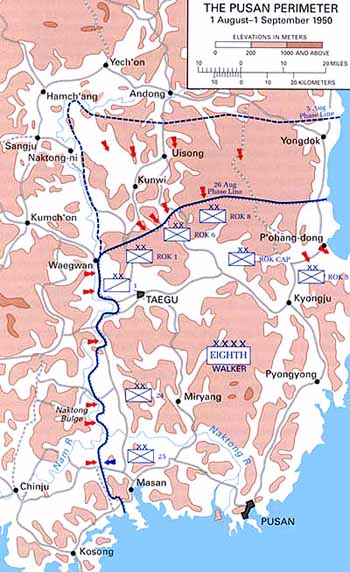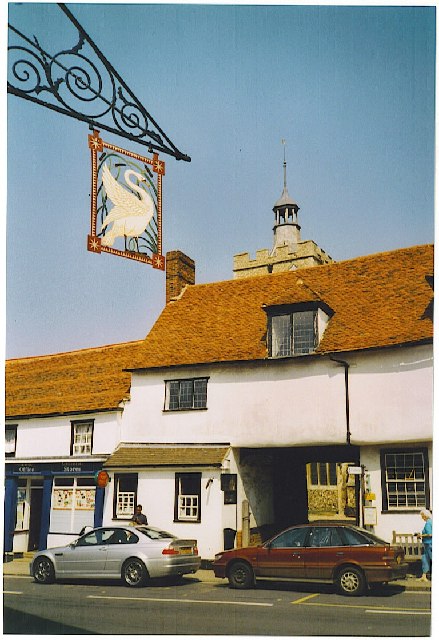|
Basil Coad
Major General Basil Aubrey Coad, (27 September 1906 – 26 March 1980) was a senior British Army officer. He held battalion, brigade and divisional commands during the Second World War and immediately after, but is best known as the commander of the 27th British Commonwealth Brigade during the Korean War. After his involvement in Korea, he held a further divisional command, and then a senior administrative position in the army before retiring. In retirement, he continued his connection with the army, serving as Colonel of his former regiment, and assisting in writing the British official history of the Korean War. He was also appointed a Deputy Lieutenant of Wiltshire. Early life and military career Coad was born on 27 September 1906 at Portsmouth, Hampshire. He was educated at Felsted School and Royal Military College, Sandhurst. From Sandhurst he was commissioned into the British Army as a second lieutenant in the Wiltshire Regiment on 4 February 1926. He was soon bound ... [...More Info...] [...Related Items...] OR: [Wikipedia] [Google] [Baidu] |
Charles Green (Australian Soldier)
Charles Hercules Green (26 December 19191 November 1950) was an Australian military officer who was the youngest Australian Army infantry battalion commander during World War II. He went on to command the 3rd Battalion, Royal Australian Regiment (3 RAR), during the Korean War, where he died of wounds. He remains the only commanding officer of a Royal Australian Regiment battalion to die on active service. Green joined the part-time Militia in 1936, and before the outbreak of World War II had been commissioned as a lieutenant. He volunteered for overseas service soon after the war began in September 1939, and served in the Middle East and the Battle of Greece with the 2/2nd Battalion. After the action at Pineios Gorge on 18 April 1941, Green became separated from the main body of the battalion, and made his way through Turkey to Palestine, to rejoin the reformed 2/2nd Battalion. The 2/2nd Battalion returned to Australia in August 1942 via Ceylon (modern Sri Lanka), to meet t ... [...More Info...] [...Related Items...] OR: [Wikipedia] [Google] [Baidu] |
Korean War
, date = {{Ubl, 25 June 1950 – 27 July 1953 (''de facto'')({{Age in years, months, weeks and days, month1=6, day1=25, year1=1950, month2=7, day2=27, year2=1953), 25 June 1950 – present (''de jure'')({{Age in years, months, weeks and days, month1=6, day1=25, year1=1950) , place = Korean Peninsula, Yellow Sea, Sea of Japan, Korea Strait, China–North Korea border , territory = Korean Demilitarized Zone established * North Korea gains the city of Kaesong, but loses a net total of {{Convert, 1506, sqmi, km2, abbr=on, order=flip, including the city of Sokcho, to South Korea. , result = Inconclusive , combatant1 = {{Flag, First Republic of Korea, name=South Korea, 1949, size=23px , combatant1a = {{Plainlist , * {{Flagicon, United Nations, size=23px United Nations Command, United Nations{{Refn , name = nbUNforces , group = lower-alpha , On 9 July 1951 troop constituents were: US: 70.4%, ROK: 23.3% other UNC: 6.3%{{Cite ... [...More Info...] [...Related Items...] OR: [Wikipedia] [Google] [Baidu] |
Felsted School
(Keep your Faith) , established = , closed = , type = Public schoolIndependent day and boarding , religion = Church of England , president = , head_label = Headmaster , head = Chris Townsend , r_head_label = , r_head = , chair_label = , chair = , founder = Richard Rich, 1st Baron Rich , specialist = , address = Stebbing Road , city = Felsted , county = Essex , country = England , postcode = CM6 3LL , local_authority = , urn = 115395 , ofsted = , dfeno = 881/6009 , staff = , enrolment = 1,000 , gender = Co-educational , lower_age = 4 , upper_age = 18 , houses = , colours = Burgundy (Prep School) navy blue (Senior School) , publication = , free_label_1 = Former pupils , free_1 = Old Felstedians , free_label_2 = , free_2 = , free_label_3 = , free_3 = , website ... [...More Info...] [...Related Items...] OR: [Wikipedia] [Google] [Baidu] |
Official History
An official history is a work of history which is sponsored, authorised or endorsed by its subject. The term is most commonly used for histories which are produced for a government. The term also applies to commissions from non-state bodies including histories of commercial companies. An official biography (one written with the permission, cooperation and sometimes the participation of its subject or heirs) is an authorised biography. Official histories frequently have the advantage that the author has had access to archives, been allowed to interview subjects and use other primary sources closed to independent historians. Because of the close relationship between author and subject, such works may be (or be perceived to be) partisan in tone and to lack historical objectivity. Such bias varies and some official histories have been called exercises in propaganda; in other cases the authors have retained a measure of independence. Early official histories There is a tradition of his ... [...More Info...] [...Related Items...] OR: [Wikipedia] [Google] [Baidu] |
Division (military)
A division is a large military unit or Formation (military), formation, usually consisting of between 6,000 and 25,000 soldiers. In most armies, a division is composed of several regiments or brigades; in turn, several divisions typically make up a corps. Historically, the division has been the default combined arms unit capable of independent Military tactics, operations. Smaller combined arms units, such as the American regimental combat team (RCT) during World War II, were used when conditions favored them. In recent times, modern Western militaries have begun adopting the smaller brigade combat team (similar to the RCT) as the default combined arms unit, with the division they belong to being less important. While the focus of this article is on army divisions, in naval usage "division (naval), division" has a completely different meaning, referring to either an administrative/functional sub-unit of a department (e.g., fire control division of the weapons department) aboar ... [...More Info...] [...Related Items...] OR: [Wikipedia] [Google] [Baidu] |
Brigade
A brigade is a major tactical military formation that typically comprises three to six battalions plus supporting elements. It is roughly equivalent to an enlarged or reinforced regiment. Two or more brigades may constitute a division. Brigades formed into divisions are usually infantry or armored (sometimes referred to as combined arms brigades). In addition to combat units, they may include combat support units or sub-units, such as artillery and engineers, and logistic units. Historically, such brigades have sometimes been called brigade-groups. On operations, a brigade may comprise both organic elements and attached elements, including some temporarily attached for a specific task. Brigades may also be specialized and comprise battalions of a single branch, for example cavalry, mechanized, armored, artillery, air defence, aviation, engineers, signals or logistic. Some brigades are classified as independent or separate and operate independently from the traditional divi ... [...More Info...] [...Related Items...] OR: [Wikipedia] [Google] [Baidu] |
Battalion
A battalion is a military unit, typically consisting of 300 to 1,200 soldiers commanded by a lieutenant colonel, and subdivided into a number of companies (usually each commanded by a major or a captain). In some countries, battalions are exclusively infantry, while in others battalions are unit-level organizations. The word battalion came into the English language in the 16th century from the French language ( French: ''bataillon'' meaning "battle squadron"; Italian: ''battaglione'' meaning the same thing; derived from the Vulgar Latin word ''battalia'' meaning "battle" and from the Latin word ''bauttere'' meaning "to beat" or "to strike"). The first use of the word in English was in the 1580s. Description A battalion comprises two or more primary mission companies which are often of a common type (e.g., infantry, tank, or maintenance), although there are exceptions such as combined arms battalions in the U.S. Army. In addition to the primary mission companies, a battal ... [...More Info...] [...Related Items...] OR: [Wikipedia] [Google] [Baidu] |
Duke Of Edinburgh's Royal Regiment
The Duke of Edinburgh's Royal Regiment (Berkshire and Wiltshire) was an infantry regiment of the British Army. History Earlier history The regiment was formed on 9 June 1959 after defence cuts implemented in the late 1950s saw the amalgamation of the Royal Berkshire Regiment (Princess Charlotte of Wales's) and Wiltshire Regiment (Duke of Edinburgh's), forming the Duke of Edinburgh's Royal Regiment (Berkshire and Wiltshire). The amalgamation parade to create the new regiment took place at Albany Barracks, Isle of Wight, when it also received its first set of Colours, presented by its Colonel-in-Chief, the Prince Philip, Duke of Edinburgh. Until the early 1980s, the regiment's administrative headquarters (RHQ) was at Brock Barracks, Reading, Berkshire, with a secondary or subsidiary headquarters at Le Marchant Barracks, Devizes, Wiltshire, but by 1982 a single RHQ had been permanently established in the Cathedral Close at Salisbury, Wiltshire, with the DERR regimental museum, - i ... [...More Info...] [...Related Items...] OR: [Wikipedia] [Google] [Baidu] |
Colonel (United Kingdom)
Colonel (Col) is a rank of the British Army and Royal Marines, ranking below brigadier, and above lieutenant colonel. British colonels are not usually field commanders; typically they serve as staff officers between field commands at battalion and brigade level. The insignia is two diamond-shaped pips (properly called "Bath Stars") below a crown. The crown has varied in the past with different monarchs; Elizabeth II's reign used St Edward's Crown. The rank is equivalent to captain in the Royal Navy and group captain in the Royal Air Force. Etymology The rank of colonel was popularized by the tercios that were employed in the Spanish Army during the 16th and 17th centuries. General Gonzalo Fernández de Córdoba divided his troops in to ''coronelías'' (meaning "column of soldiers" from the Latin, ''columnella'' or "small column"). These units were led by a ''coronel''. This command structure and its titles were soon adopted as ''colonello'' in early modern Italian and in Mi ... [...More Info...] [...Related Items...] OR: [Wikipedia] [Google] [Baidu] |
Legion Of Merit
The Legion of Merit (LOM) is a military award of the United States Armed Forces that is given for exceptionally meritorious conduct in the performance of outstanding services and achievements. The decoration is issued to members of the eight uniformed services of the United States Note: National Oceanic and Atmospheric Administration Commissioned Officer Corps Amendments Act of 2012 amended the Legion of Merit to be awarded to any uniformed service. as well as to military and political figures of foreign governments. The Legion of Merit (Commander degree) is one of only two United States military decorations to be issued as a (the other being the |
Medal Bar
A medal bar or medal clasp is a thin metal bar attached to the ribbon of a military decoration, civil decoration, or other medal. It most commonly indicates the campaign or operation the recipient received the award for, and multiple bars on the same medal are used to indicate that the recipient has met the criteria for receiving the medal in multiple theatres. When used in conjunction with decorations for exceptional service, such as gallantry medals, the term "and bar" means that the award has been bestowed multiple times. In the example, "Group Captain Leonard Cheshire, VC, OM, DSO and two bars, DFC", "DSO and two bars" means that the Distinguished Service Order was awarded on three occasions. A British convention is to indicate bars by the use of asterisks; thus, DSO** would denote a DSO and two bars. Bars are also used on long-service medals to indicate the length of service rendered. The two terms are used because terms "bar" and "clasp" both refer to two parts of the ... [...More Info...] [...Related Items...] OR: [Wikipedia] [Google] [Baidu] |




